
The Sarajevo Synagogue is an Orthodox Jewish congregation and synagogue, located on the south bank of the river Miljacka, in Sarajevo, in Bosnia and Herzegovina. The synagogue was constructed in 1902 and is the only functioning synagogue in Sarajevo today. The congregation worships in the Ashkenazi rite.
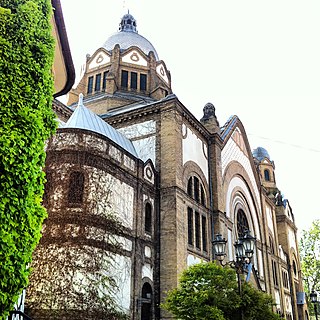
The Novi Sad Synagogue is a former Neolog Jewish congregation and synagogue, located on Jevrejska (Jewish) Street, in the city center of Novi Sad, in the province of Vojvodina, Serbia. Completed in 1909, the building was used as a synagogue until c. 1966; and subsequently used as cultural center since 2012. During its use, with a capacity of 900 worshipers, the synagogue was one of the largest synagogues in Central Europe.

The Dohány Street Synagogue, also known as the Great Synagogue or Tabakgasse Synagogue, is a Neolog Jewish congregation and synagogue, located on Dohány Street in Erzsébetváros of Budapest, Hungary. It is the largest synagogue in Europe, seating 3,000 people, and is a centre of Neolog Judaism. The congregation worships in the Ashkenazi rite.

The Tempel Synagogue is a Reform Jewish congregation and synagogue, located at 24 Miodowa Street, in the historic Kazimierz district of Kraków, in the Lesser Poland Voivodeship of Poland. Designed by Ignacy Hercok in the Moorish Revival and Rundbogenstil styles and completed in 1862, the synagogue is a major place of worship, and also a booming center of Jewish culture, which hosts numerous concerts and meetings, especially during the Kraków Jewish Culture Festival.

The Zasanie Synagogue is a former Jewish congregation and synagogue, located in Przemyśl, in Podkarpackie Voivodeship, Poland. It was the only synagogue in Przemyśl built on the western bank of the San River. Completed in 1909, it served as a house of prayer for thirty years until World War II. Along with the New Synagogue, the Zasanie Synagogue is one of the two remaining synagogue buildings in Przemyśl.

Marcali is a town in Somogy County, Hungary, and the seat of Marcali District.
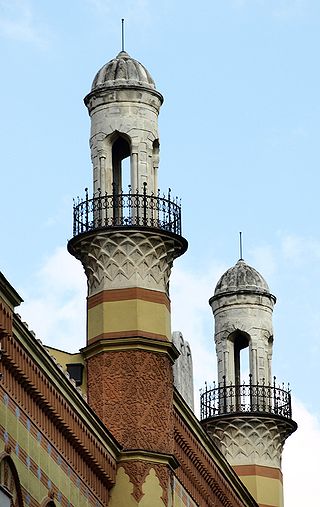
The Rumbach Street Synagogue, also called the Status Quo Ante Synagogue, is a Neológ congregation and synagogue, located in Belváros, the inner city of the historical old town of Pest, in the eastern section of Budapest, Hungary. Since 2021, the building has also been used as a concert hall and Jewish museum.

The New Synagogue, also called Scheinbach’s Synagogue, is a former Orthodox Jewish congregation and synagogue, located at Juliusza Słowackiego 15, in Przemyśl, in the Podkarpackie Voivodeship of Poland. Designed by Stanisław Majerski and completed in 1918, the synagogue served as a house of prayer until World War II when it was desecrated by Nazis in 1939.

The Óbuda Synagogue is an Orthodox Jewish congregation and synagogue, located in Óbuda, in the III district of Budapest, Hungary. The synagogue was completed in 1821 by an Orthodox congregation who worshipped in the Ashkenazi rite, founded in the 1730s. The congregation made a change to Neolog in 1831; and, since 2010, have followed the Orthodox Chabad movement, worshipping in the Ari rite.

The Lendava Synagogue is a former Orthodox Jewish congregation and synagogue, located in the small town of Lendava, Slovenia, a town that is close to the Hungarian border. The former congregation was established in 1773 and worshiped in the Ashkenazi rite. The former synagogue was completed in 1866 and was used as a synagogue up until 1944, when the community perished in The Holocaust.

The Cytron Synagogue, also known as the Beit Midrash Cytron, is a former Orthodox Jewish congregation and synagogue, located at 24a Ludwika Waryńskiego Street in Białystok, in Podlaskie Voivodeship, Poland. Completed in 1936 in the Modernist style, the construction was funded by Shmuel Cytron, it served as a house of prayer until World War II; subsequently used for profane purposes, and as the Sleńdzińscy Gallery, an art gallery.

The Piaskower Synagogue is a former Orthodox Jewish congregation and synagogue, located at 3 Piękna Street, in the Piaski district of Białystok, in the Podlaskie Voivodeship of Poland.
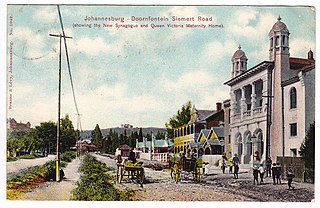
The Doornfontein Synagogue or Lions Synagogue is an Orthodox Jewish congregation and synagogue, located at 120 Siemert Road, New Doornfontein, in Greater Johannesburg, in the region of Gauteng, South Africa. It is the oldest synagogue in use in South Africa. The synagogue is located two blocks from Ellis Park Stadium.

The Rákospalota Synagogue is a former Neolog Jewish congregation and synagogue, located on Old Fóti Road in Rákospalota, in the XVth district of Budapest, Hungary. Completed in 1927, the building was used a synagogue until World War II, subsequently for profane use, including as a warehouse, from the 1960s.

The Kazinczy Street Synagogue, variously called the Sasz-Chevra Synagogue and the Great Orthodox Synagogue is an Orthodox Jewish congregation and synagogue complex, located at 29–31 Kazinczy Street, in Pest, in the VII district of Budapest, Hungary. The congregation worships in the Ashkenazi rite.

The Szolnok Synagogue is a former Neolog Jewish synagogue, located at Templom út 2, in Szolnok, in the county of Jász-Nagykun-Szolnok, Hungary. Completed in 1898, the building was used a synagogue until World War II and, following restoration, has been used as the Szolnok Gallery, an art gallery, since 1960.
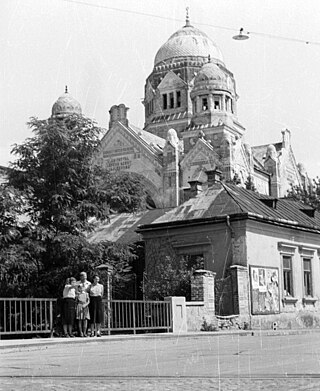
The Eger Synagogue is a former Neolog Jewish synagogue that was located in Eger, Hungary. Completed in 1913, the building was used a synagogue until World War II and profane use until its demolition in 1967.

The Nyíregyháza Synagogue, or Nyíregyháza New Synagogue, is an Orthodox Jewish congregation and synagogue, located in the town of Nyíregyháza, in the Great Hungarian Plains region, in the county of Szabolcs-Szatmár-Bereg, Hungary. The building was completed in 1932. The congregation was founded by Neolog Jews in 1865, who worshipped in the Ashkenazi rite. The congregation later merged to form an Orthodox community who ceased worshipping in the Ashkenazi tradition after World War II.

The Gyöngyös Synagogue, also called the Great New Synagogue, is a former Neolog Jewish synagogue, located in Gyöngyös, Hungary. Completed in 1930, the building was used a synagogue until World War II, subsequently for profane use, and in 2014 it was announced that the former synagogue would be transformed into a cultural center.
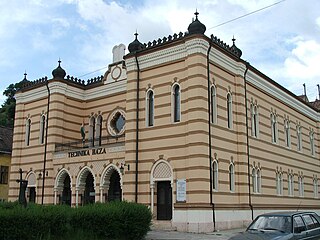
The Esztergom Synagogue is a former Jewish congregation and synagogue, located in the town of Esztergom, Hungary. The synagogue was built in 1859, renovated in 1888, and severely damaged by a bombing during World War II. Since almost all Jewish people in the town were deported during the Holocaust and Communists subsequently gained control of the country, the building has not been used for religious purposes since the 1940s.





















